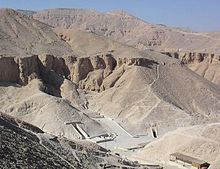Tomb discovered in Valley of the Kings
Friday, February 10, 2006

Archaeologists have discovered a tomb, referred to as KV63, in Egypt's Valley of the Kings. It is the first such discovery since Howard Carter's 1922 discovery of Tutankhamun's tomb. The discovery was made by a team from the University of Memphis. Zahi Hawass, head of the Supreme Council of Antiquities said in a statement that five intact sarcophagi that all contained mummies and 20 large storage jars that were sealed with pharaonic seals had been recovered.
American archaeologist Kent Weeks, who was not part of the team but had seen photographs of the site, told the Associated Press that "It could be the tomb of a king's wife or son, or of a priest or court official". The find refutes the long held belief that the Valley of the Kings has little left to discover. According to Weeks: "It's ironic. A century ago, people said the Valley of the Kings is exhausted, there's nothing left," he said. "Suddenly Carter found Tutankhamun. So then they said, 'Now there's nothing to find.' Then we found KV5. Now we have KV63."
KV63 is located in the area between KV10 (Amenmesse) and KV62 (Tutankhamun), in the very centre of the Valley's eastern branch and near the main crossroads of the network of paths traversed by thousands of tourists every day. The tomb was found at a depth of some three metres beneath the ground. The burial site is believed to date from the latter portion of the 18th dynasty (ca. 14th century BC), but the occupants have not yet been identified.
Sources
[edit]- Lee Keath. "Archaeologists uncover first Valley of the Kings tomb since 1922 Tutankhamun find" — The Guardian, February 10, 2006
- AP. "Five mummies found at famed Egyptian site" — CNN News, February 9, 2006

